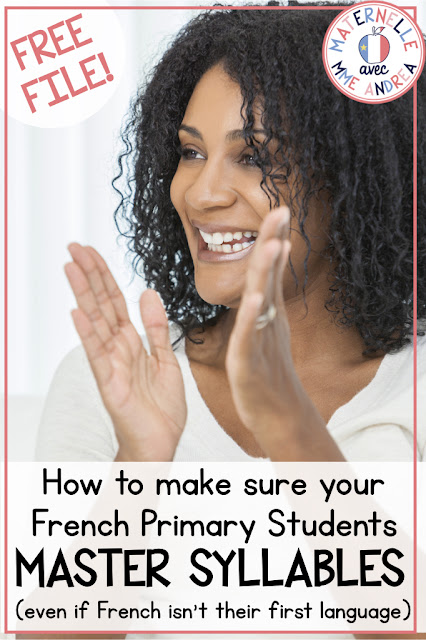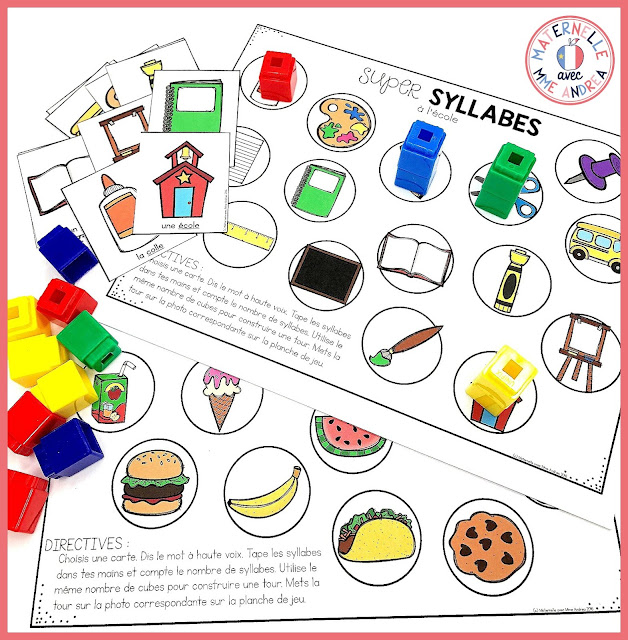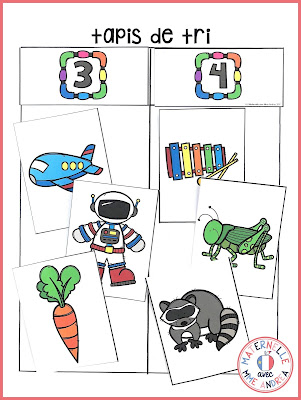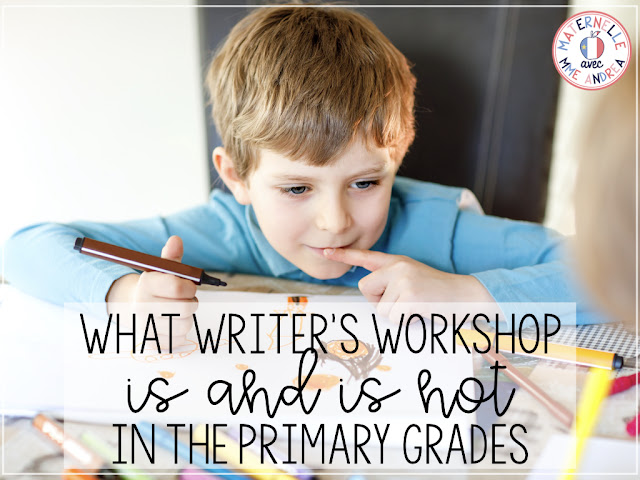Imagine you are doing guided reading with one of your best maternelle students.
They are reading along, their little voice getting stronger and more confident with every sentence, when all of a sudden, they reach a new word.
A new word, BUT a word that just contains sounds they know (lavabo, for example).
So, you stay quiet, holding your breath, sitting on your hands to restrain yourself from grabbing their pointer finger to stick under the tricky word, willing them to use their strategies. You know they can do it!
They take a deep breath, put their finger under the first letter of the word, and (while you are still silently cheerleading), you hear…
“lllll-aaaa-vvvv-aaaa-bbbb-ooo… lamargaho!”
You exhale in disbelief as they keep right on going, not even realizing that lamargaho isn’t a real word. French is their second language after all… they don’t know every single word yet!
But, what even just happened?!
They read every single sound correctly… how did it end up a bunch of mumbo-jumbo when they smooshed the sounds together??
This used to happen to me ALL THE TIME.
And it is soooo frustrating!!!!
But the solution can be pretty simple… although it might involve going back to a concept you probably taught at the beginning of the year and assumed every student had mastered… because it’s pretty easy, right?
You sat your students in a circle, shouted out one name or word at a time, and had everyone clap out and say how many parts there were. Done!
That’s right – I’m talking about syllables!
And if you only did one or two lessons waaaay back at the beginning of the year… you might not actually be done ;)
Syllables might seem simple, and most students are pretty good at taking a word in isolation, clapping it out, and telling you how many parts are there.
But, if a student has truly mastered syllables, they will be able to transfer that mastery to their reading and use their knowledge of syllables to help them decode big words.
You will run into the problem of correct sounds becoming nonsense gibberish far less often.
And that’s what I will be discussing today in this blog post!
Why are syllables so important?
Being able to divide a word into syllables is an ESSENTIAL pre-reading skill!
As I’m sure you know, as students learn to decode new words while reading, it is much more efficient for them to read words in chunks, rather than stretching out each letter – especially when reading longer words.
That’s what happened in the above example, and happens often in maternelle and première année, as students are learning to read.
They get so excited about knowing all their sounds, that they don’t realize little words they already know are hidden inside of bigger words, or that they can use their knowledge of syllables to help them read more efficiently.
For the student who was trying to read lavabo, for example, it would have been much easier to read it as “la-va-bo” than to read it as “llll-aaa-vvv-aaa-bbb-ooo” and then try to remember all of the letters they just said!
If you want to read salade, then “sa-la-de” is way simpler than “ssss-aaa-lll-aaa-ddd-eee“.
And if you wanted to read the longest French word in existence, you would definitely want to read it as hip-po-pot-o-mon-stro-ses-quip-ped-a-li-o-pho-bie, rather than trying to sound out every single letter!
(Interestingly, hippopotomonstrosesquippedaliophobie is the name of the phobia of long words, en français. Nothing like making someone afraid of their own diagnosis!)
Our students must practice breaking words into chunks like this, and practice putting the chunks back together again so they are USED to doing this when they begin to read.
So, how can you help your students become syllable masters?
How can you get them thinking about breaking big words into little pieces?
The answer is pretty simple, but it isn’t something every teacher does.
Syllables seem pretty easy and basic, and students often seem like they know what they are doing after a couple of lessons.
So it might happen that you do a lesson or two, everyone seems to have it down pat, and so you move on.
(May or may not be speaking from experience, here haha)
But here is the little secret…
Your students really do need to practice, practice, practice!
You want to practice early, practice often, and practice in a variety of ways.
Even when it seems like your students can count syllables in their sleep… keep practicing!
And a great way to introduce this skill is to practice orally.
To be successful readers, students MUST become able to hold each syllable in their mind, and then string them back together.
You don’t need worksheets or game boards to practice this skill with your students (although those are fun and awesome, too!).
You can start practicing as soon as tomorrow using only your mouths and your brains!
You might want to try giving your students syllables to put together and have them work backward. So, you would say “la…. va…. bo” and then your students would put those chunks together to make the word lavabo.
Or, you can give your students the word right away, and ask them to divide it into syllables themselves and tell you how many there.
Practicing dividing words into chunks orally and putting them back together over and over in a relaxed, fun environment (like while playing a game), can help students transfer these skills to print when they are ready to learn to read.
You can use silly words, funny words, nonsense words, new words, old words, student names, family members’ names, staff members’ names… anything!
And speaking of games…
Games are engaging, and help students retain information with much less effort on their part.
The games I use for syllables are super simple, but my students enjoy them and always ask for more. If you have been looking for a way to incorporate syllable practice with your small groups, this game is my go-to :
Some have seasonal or holiday themes, but some you can use at any time of year.
The game is super simple and pretty low prep! All you need are the desired game boards, the 15 corresponding word cards, and snap cubes. I laminate my cards and cut them with my paper cutter – each game board only has one sheet of cards, so it’s pretty quick!
Students draw one card at a time and name the image. I have written the word on the card, but would never expect my students to READ it yet – if the object on the card is one they are unfamiliar with, I (or another group member) will tell them the word.
The underlined word(s) is what I want them to count (not the article). They MUST say the word out loud before counting. After saying the word out loud, they break it into chunks (orally) and count how many syllables. Of course, they then have to put the word back together for me!
I use this as a cooperative game, and we all work together to fill the board as quickly as possible, but you could also get your students to compete against each other by providing different coloured cubes.
However, I have also included an “I Can” card that you can print and use if your students are already pros and you would like to use this game as an independent centre.
>> Click HERE to see Super Syllabes in my TPT store
Another tip for increasing engagement is to use fun manipulates and materials wherever possible!
You can give your students a handful of seasonal erasers or objects, and as they divide a given word into syllables, have them place an object on the table for each part of the word. They will then be able to count how many syllables were in the word.
We do syllable worksheets sometimes, and my students LOVE them… because I give them bingo daubers!
Check out this video of a student completing a syllable counting worksheet:
It can also be helpful to encourage your students to take their thinking about syllables a step farther.
For example, I will sometimes ask my students to not only count how many syllables are in a word, but to also sort pictures of words into groups based on how many syllables they have.
This helps ensure that they are counting syllables and thinking about what they find, rather than just counting syllables in a word and then moving on to the next word.
>>> Click HERE to see my Syllable Sorting Mats on TPT
You could also give your students a number between one and four, and ask them to come up with a word with that many syllables. You could provide a bank of vocabulary words, or allow them to use any words they choose.
And…
If you are interested in learning more about what I do to teach syllables (and why I think they are so important!) check out my FREE e-book (tout en français) all about helping your French primary students master syllables.
There is even a game inside that you can use as a guided reading warm up, or as a literacy centre once your students are pros.
Just enter your name & email below, and I will send you the free e-book right away!
Once your students are oral syllable masters, you will want to move on and encourage them to practice reading small syllables.
First, you will want them to read small syllables in isolation, before moving on to taking big words and breaking them into chunks.
If you feel that your students have truly mastered syllables and are ready for the next step (reading small words and syllables in isolation, and then moving on to reading big words from their books using syllables), I have a few more blog posts that might be helpful to you.
When you give your students time and opportunity to master syllables, their little brains will be more ready to decode bigger words as they start to read.
They will already be used to holding sounds and syllables in their minds and putting them together to create words that make sense.
They will be able to remember that big words are made up of small chunks, and they will find them and smoosh them together to create real words, not a mishmash of mumbo-jumbo gibberish.
And your sweet little French primary students will be true syllable masters!










I am using your syllable gameboard in my literacy centers and my students love it. Thankyou so much for the free download.
Yay!! I am so glad they love it :) Thanks for letting me know!